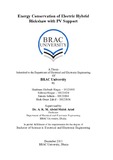| dc.contributor.advisor | Azad, A. K. M. Abdul Malek | |
| dc.contributor.author | Haque, Shadman Shabaab | |
| dc.contributor.author | Sabrina, Hoque | |
| dc.contributor.author | Sabnin, Sanam | |
| dc.contributor.author | Zahid, Shah Omer | |
| dc.date.accessioned | 2014-03-22T06:54:49Z | |
| dc.date.available | 2014-03-22T06:54:49Z | |
| dc.date.copyright | 2013 | |
| dc.date.issued | 2013-12 | |
| dc.identifier.other | ID 10121091 | |
| dc.identifier.other | ID 10121029 | |
| dc.identifier.other | ID 10121084 | |
| dc.identifier.other | ID 10121036 | |
| dc.identifier.uri | http://hdl.handle.net/10361/3067 | |
| dc.description | This thesis report is submitted in partial fulfillment of the requirements for the degree of Bachelor of Science in Electrical and Electronic Engineering, 2013. | |
| dc.description | Cataloged from PDF version of thesis report. | |
| dc.description | Includes bibliographical references (page 65). | |
| dc.description.abstract | In Bangladesh, The most used mode of public transportation is the rickshaw. This Is because of its itinerary, time flexibility and door--‐to--‐door services. Since, Considerable fraction of population in Bangladesh uses the rickshaw and a major part of underprivileged population are either directly or indirectly dependent upon the rickshaw--‐pulling profession, the necessity of modernizing this mode is evident.
Newly designed green electric rickshaw was invented which eliminated manual labor of
Rickshaw puller and increased their daily income but one of the main disadvantages of these rickshaws is that it has to recharged almost everyday. These vehicles use up the energy stored in the battery, at the end of the day the battery has to be recharged from the national grid. Due to present deficiency of power already prevailing in the country, the
government has banned this rickshaw due to its high power consumption.
Our thesis describes a research and development project of Control and Applications Research Centre (CARC), BRAC University, aiming to show the conservation of energy
for these green fuel--‐free vehicles by PV assistance. This involves the installation of PV
panels on top of the vehicles so that, when at rest, the battery can be charged by this panel.
During motion, the PV panel and the battery will simultaneously run the motor. Thus, this
Also involves the development design and algorithmic implementation of a charge controller. Additionally, the structure for panel installation is also sought. The goal being
the overall power needed from the ‘mother’ grid being reduced. | en_US |
| dc.description.statementofresponsibility | Shadman Shabaab Haque | |
| dc.description.statementofresponsibility | Sabrina Hoque | |
| dc.description.statementofresponsibility | Sanam Sabnin | |
| dc.description.statementofresponsibility | Shah Omer Zahid | |
| dc.format.extent | 138 pages | |
| dc.language.iso | en | en_US |
| dc.publisher | BRAC University | en_US |
| dc.rights | BRAC University thesis are protected by copyright. They may be viewed from this source for any purpose, but reproduction or distribution in any format is prohibited without written permission. | |
| dc.subject | Electrical and electronic engineering | |
| dc.title | Energy conservation of Electric Hybrid Rickshaw with PV support | en_US |
| dc.type | Thesis | en_US |
| dc.contributor.department | Department of Electrical and Electronic Engineering, BRAC University | |
| dc.description.degree | B. Electrical and Electronic Engineering
| |

